Oldsmobile Aurora 1997 Owner's Manuals
Manufacturer: OLDSMOBILE, Model Year: 1997, Model line: Aurora, Model: Oldsmobile Aurora 1997Pages: 404, PDF Size: 20.75 MB
Page 281 of 404

There are only two reasons why the brake fluid level in the
reservoir might go down. The first
is that the brake fluid
goes down to
an acceptable level during normal brake
lining wear. When new linings are put in, the fluid level
goes back up. The other reason is that fluid is leaking out
of the brake system. If it is, you should have your brake
system fixed, since a leak means that sooner or later your
brakes won’t work well, or won’t work at all.
So, it isn’t a good idea to “top ofi?’ your brake fluid.
Adding brake fluid won’t correct a leak.
If you add fluid
when your linings are worn, then you’ll have too much
fluid when you get new brake linings. You should add
(or remove) brake fluid, as necessary, only when work is
done on
the brake hydraulic system. When
your brake fluid falls to a low level, your brake
warning light will come on.
A chime will sound if you
try
to drive with this warning light on. See “Brake
System Warning Light”
in the Index.
What to Add
When you do need brake fluid, use only DOT-3 brake
fluid
-- such as Delco Supreme 1 I @ (GM Part
No. 12377967). Use new brake fluid from a sealed
container only.
Always clean the brake fluid reservoir cap and the area
around the cap before removing
it. This will help keep
dirt from entering
the reservoir.
If you have too much brake fluid, it can spill on the
engine. The fluid will burn
if the engine is hot
enough.
You or others could be burned, and your
vehicle could be damaged. Add brake fluid only
when work is done on the brake hydraulic system. With the wronb -4nd
of fluid in your
brake
system, your brakes may not work well, or they
may not even work at all. This could cause
a
crash. Always use the proper brake fluid.
Page 282 of 404
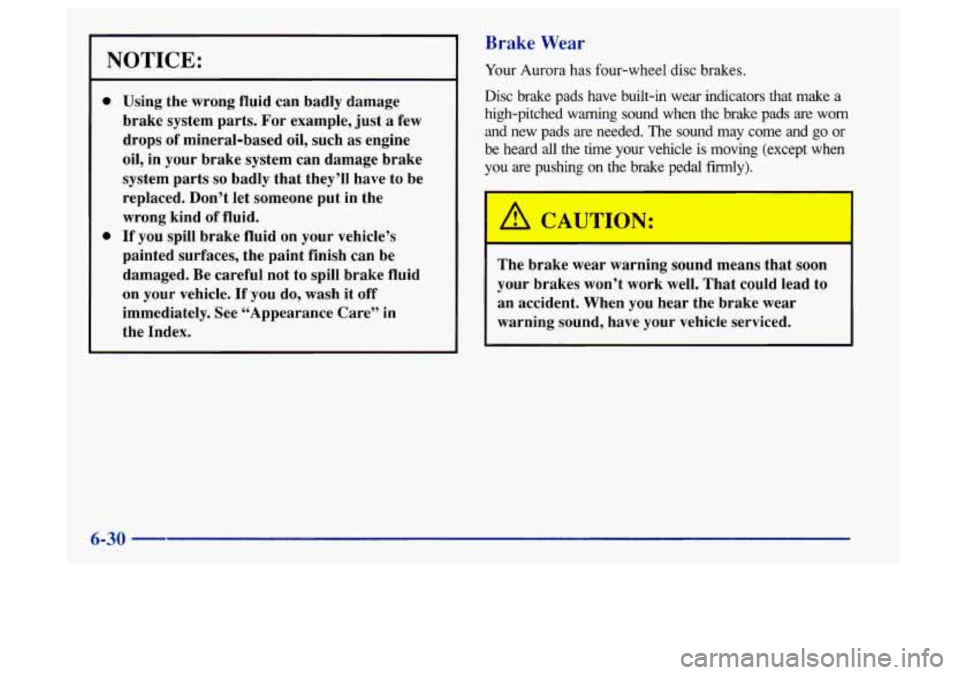
NOTICE:
Using the wrong fluid can badly damage
brake system parts. For example, just
a few
drops
of mineral-based oil, such as engine
oil, in your brake system can damage brake
system parts
so badly that they’ll have to be
replaced. Don’t let someone put in the
wrong kind of fluid.
If you spill brake fluid on your vehicle’s
painted surfaces, the paint finish can be
damaged. Be careful not to spill brake fluid
on your vehicle.
If you do, wash it off
immediately. See “Appearance Care” in
the Index.
Brake Wear
Your Aurora has four-wheel disc brakes.
Disc brake pads have built-in wear indicators that make a
high-pitched warning sound when
the brake pads are worn
and new pads are needed. The sound may come and go or
be heard all the time your vehicle is moving (except when
you are pushing on the brake pedal fiily).
The brake wear warning sound means that soon
your brakes won’t work well. That could lead to
an accident. When you hear the brake wear
warning sound, have your vehicle serviced.
Page 283 of 404
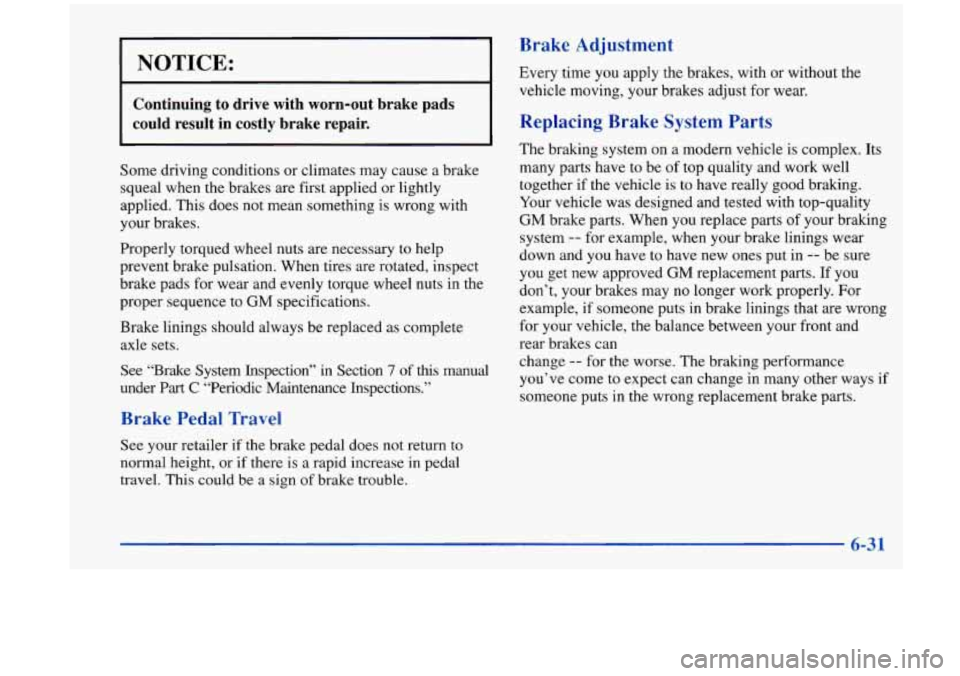
Brake Ad-iustment
NOTICE:
Continuing to drive with worn-out brake pads
could result
in costly brake repair.
Some driving conditions or climates may cause a brake
squeal when the brakes are first applied or lightly
applied. This does not mean something is wrong with
your brakes.
Properly torqued wheel nuts are necessary to help
prevent brake pulsation. When tires are rotated, inspect brake pads for wear and evenly torque wheel nuts in the
proper sequence to GM specifications.
Brake linings should always be replaced as complete
axle sets.
See “Brake System Inspection”
in Section 7 of this manual
under
Part C “Periodic Maintenance Inspections.”
Brake Pedal Travel
See your retailer if the brake pedal does not return to
normal height, or if there is a rapid increase in pedal
travel. This could be a sign
of brake trouble. Every
time you apply the brakes, with or without the
vehicle moving, your brakes adjust for wear.
Replacing Brake System Parts
The braking system on a modern vehicle is complex. Its
many parts have to be of top quality and work well
together if the vehicle is to have really good braking.
Your vehicle was designed and tested with top-quality
GM brake parts. When you replace parts
of your braking
system
-- for example, when your brake linings wear
down and
you have to have new ones put in -- be sure
you get new approved GM replacement parts. If you
don’t, your brakes may no longer work properly. For
example, if someone puts in brake linings that are wrong
for your vehicle, the balance between your front and
rear brakes can
change
-- for the worse. The braking performance
you’ve come to expect can change in many other ways
if
someone puts in the wrong replacement brake parts.
Page 284 of 404
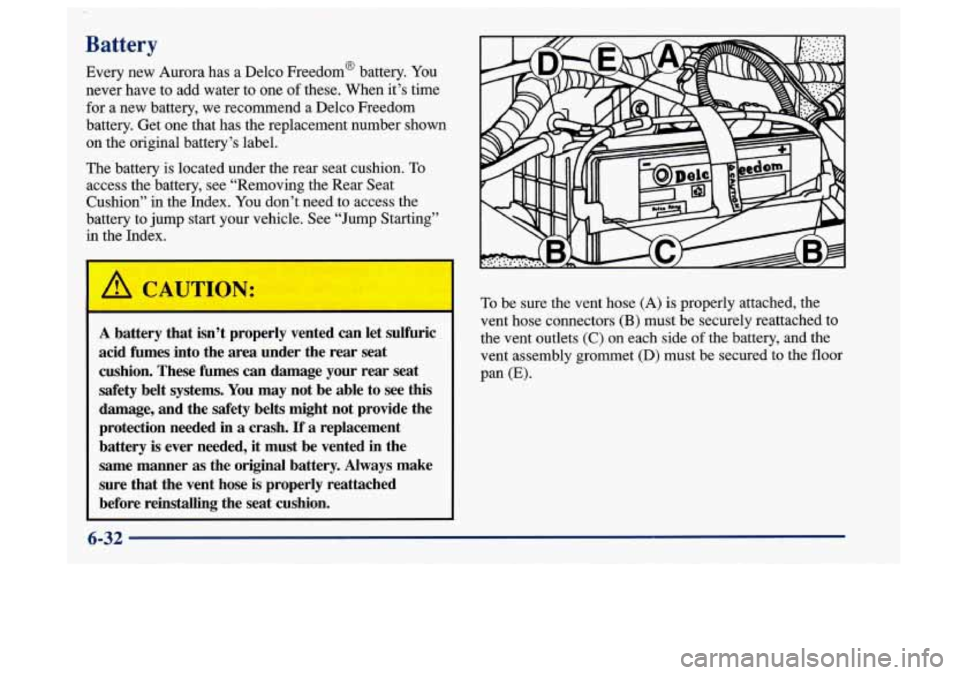
Battery
Every new Aurora has a Delco Freedom@ battery. You
never have to add water to one
of these. When it’s time
for a new battery, we recommend a Delco Freedom
battery. Get one that has the replacement number shown
on the original battery’s label.
The battery
is located under the rear seat cushion. To
access the battery,’ see “Removing the Rear Seat
Cushion”
in the Index. You don’t need to access the
battery to jump start your vehicle. See “Jump Starting”
in the Index.
A battery that isn’t properly vented can let sulfuric
acid fumes into the
area under the rear seat
cushion. These fumes can damage your rear seat
safety belt systems. You may not be able to see
this
damage, and the safety belts might not provide the
protection needed in
a crash. If a replacement
battery
is ever needed, it must be vented in the
same manner
as the original battery. Always make
sure that the vent hose
is properly reattached
before reinstalling the seat cushion.
To be sure the vent hose (A) is properly attached, the
vent hose connectors
(B) must be securely reattached to
the vent outlets
(C) on each side of the battery, and the
vent assembly grommet
(D) must be secured to the floor
pan
(E).
6-32
Page 285 of 404
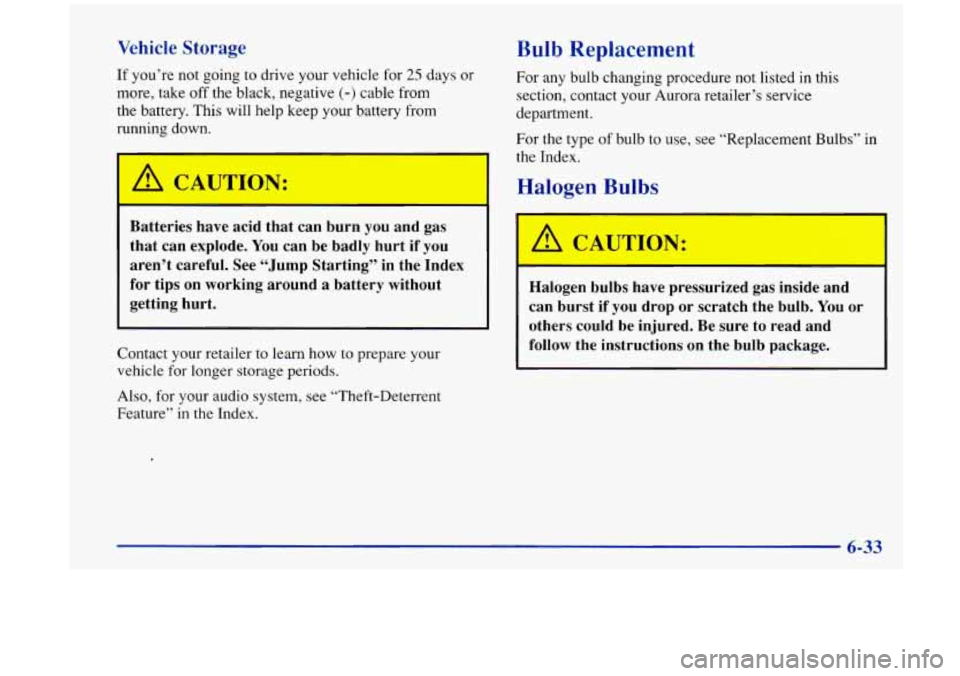
Vehicle Storage
If you’re not going to drive your vehicle for 25 days or
more, take off the black, negative
(-) cable from
the battery. This will help keep your battery from
r ning down.
A CAUTION:
Batteries have acid that can burn you and gas
that can explode.
You can be badly hurt if you
aren’t careful. See
“Jump Starting” in the Index
for tips on working around
a battery without
getting hurt.
Contact your retailer to learn how to prepare your
vehicle for longer storage periods.
Also, for your audio system, see “Theft-Deterrent
Feature”
in the Index.
Bulb Replacement
For any bulb changing procedure not listed in this
section, contact your Aurora retailer’s service
department.
For the type of bulb to
use, see “Replacement Bulbs” in
the Index.
Halogen Bulbs
I A CAUTION:
Halogen bulbs have pressurized gas inside and
can burst if you drop or scratch the bulb.
You or
others could be injured. Be sure to read and
follow the instructions on the bulb package.
Page 286 of 404
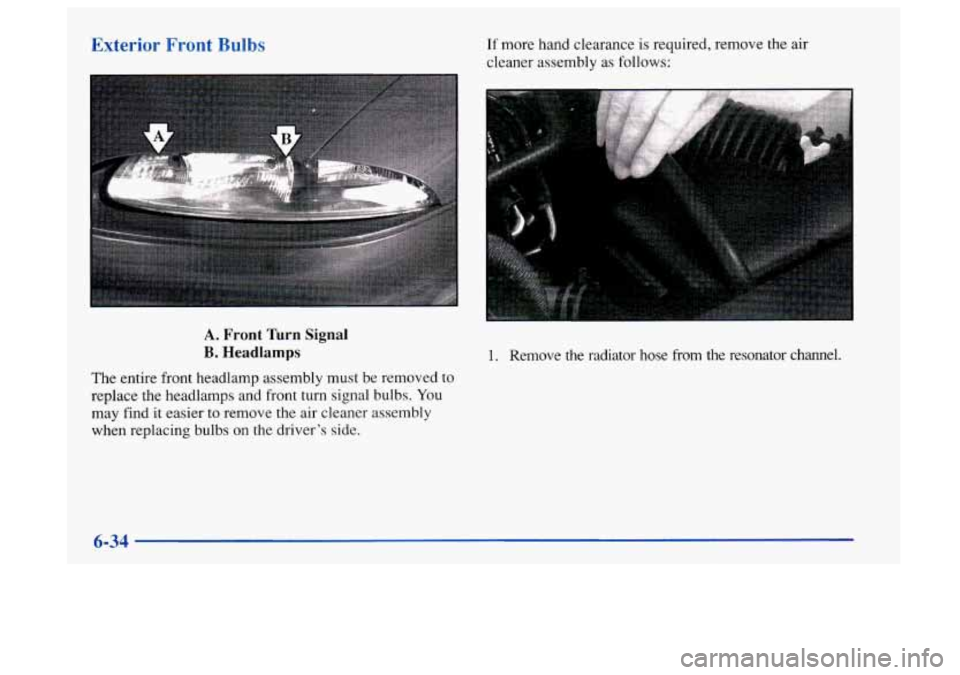
Exterior Front Bulbs If more hand clearance is required, remove the air
cleaner assembly as follows:
A. Front Wrn Signal
B. Headlamps
The entire front headlamp assembly must be removed to
replace the headlamps and front turn signal bulbs.
You
may find it easier to remove the air cleaner assembly
when replacing bulbs on the driver’s side.
1. Remove the radiator hose fi-om the resonator channel.
6-34
Page 287 of 404
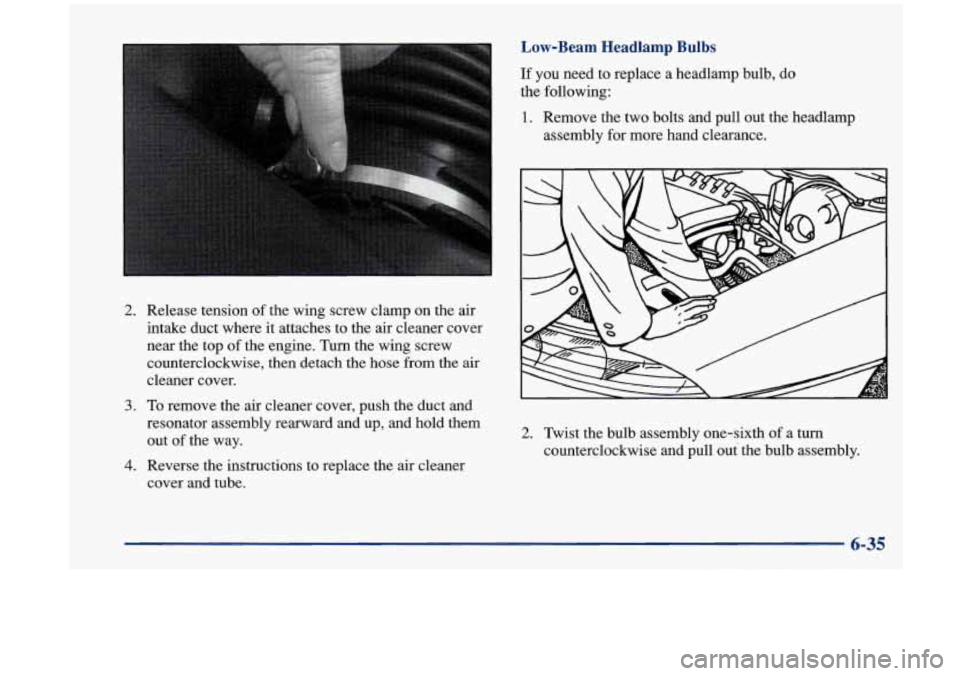
2. Release tension of the wing screw clamp on the air
intake duct where it attaches to the air cleaner cover
near the top of the engine.
Turn the wing screw
counterclockwise, then detach the hose
from the air
cleaner cover.
3. To remove the air cleaner cover, push the duct and
resonator assembly rearward and up, and hold them
out
of the way.
cover and tube.
4. Reverse the instructions to replace the air cleaner
Low-Beam Headlamp Bulbs
If you need to replace a headlamp bulb, do
the following:
1. Remove the two bolts and pull out the headlamp
assembly for more hand clearance.
2. Twist the bulb assembly one-sixth of a turn
counterclockwise and pull out the bulb assembly.
6-35
Page 288 of 404
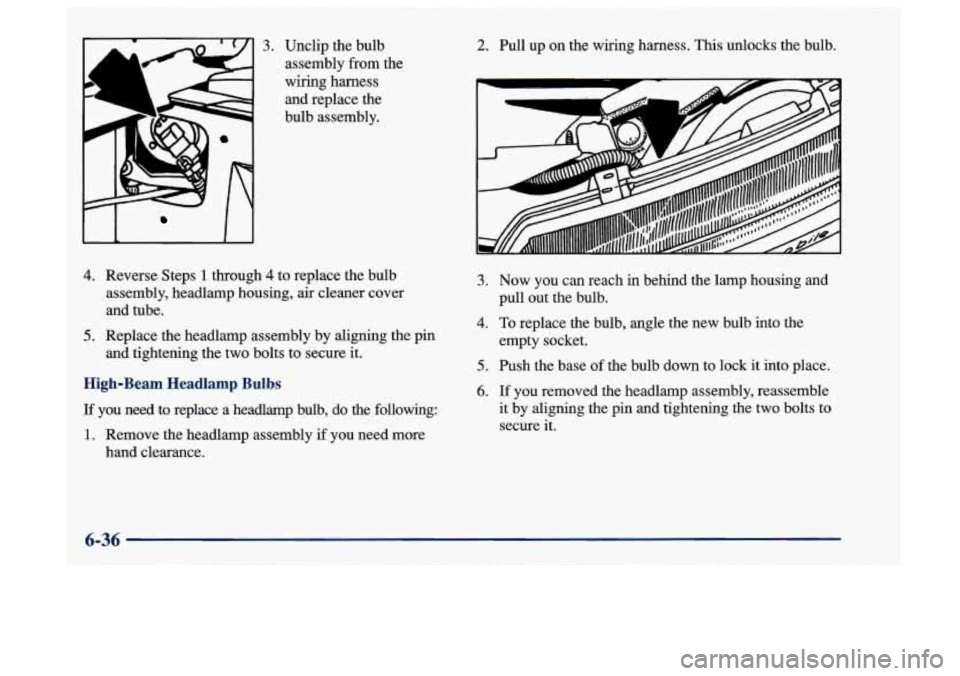
3.
II II
Unclip the bulb
assembly from the
wiring harness and replace the
bulb assembly.
4. Reverse Steps 1 through 4 to replace the bulb
assembly, headlamp housing, air cleaner cover
and tube.
5. Replace the headlamp assembly by aligning the pin
and tightening the two bolts to secure it.
High-Beam Headlamp Bulbs
If you need to replace a headlamp bulb, do the following:
1. Remove the headlap assembly if you need more
hand clearance.
2. Pull up on the wiring harness. This unlocks the bulb.
- v-
3. Now you can reach in behind the lamp housing and
4. To replace the bulb, angle the new bulb into the
pull out
the bulb.
empty socket.
5. Push the base of the bulb down to lock it into place.
6. If you removed the headlamp assembly, reassemble
it by aligning the pin and tightening the two bolts to
secure it.
Page 289 of 404
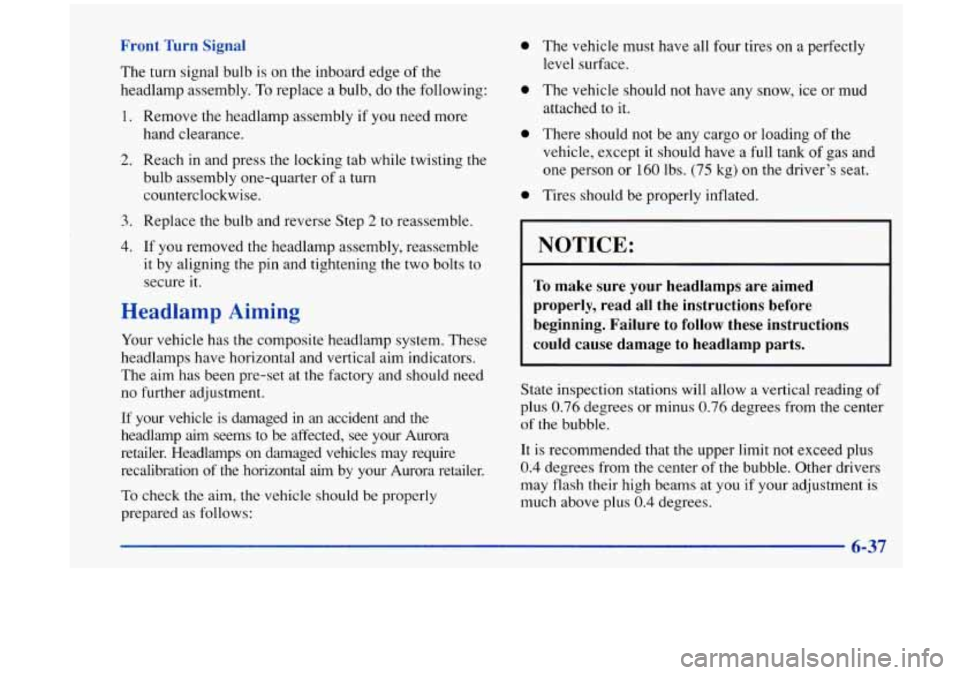
Front Turn Signal
The turn signal bulb is on the inboard edge of the
headlamp assembly.
To replace a bulb, do the following:
1.
2.
3.
4.
Remove the headlamp assembly if you need more
hand clearance.
Reach in and press the locking tab while twisting the
bulb assembly one-quarter of a turn
counterclockwise.
Replace the bulb and reverse Step
2 to reassemble.
If you removed the headlamp assembly, reassemble
it by aligning the pin and tightening the two bolts to
secure
it.
Headlamp Aiming
Your vehicle has the composite headlamp system. These
headlamps have horizontal and vertical aim indicators.
The aim has been pre-set at the factory and should need
no further adjustment.
If your vehicle is damaged in an accident and the
headlamp aim seems
to be affected, see your Aurora
retailer. Headlamps on damaged vehicles may require
recalibration
of the horizontal aim by your Aurora retailer.
To check the aim, the vehicle should be properly
prepared as
follows:
e
0
e
The vehicle must have all four tires on a perfectly
level surface.
The vehicle should not have
any snow, ice or mud
attached to it.
There should not be any cargo or loading of the
vehicle, except it should have a full tank
of gas and
one person or
160 lbs. (75 kg) on the driver’s seat.
Tires should be properly inflated.
I NOTICE:
To make sure your headlamps are aimed
properly, read all the instructions before
beginning. Failure to
follow these instructions
could cause damage to headlamp parts.
State inspection stations will allow a vertical reading of
plus
0.76 degrees or minus 0.76 degrees from the center
of the bubble.
It is recommended that the upper limit not exceed plus
0.4 degrees from the center of the bubble. Other drivers
may flash their high beams at
you if your adjustment is
much above plus
0.4 degrees.
6-37
Page 290 of 404
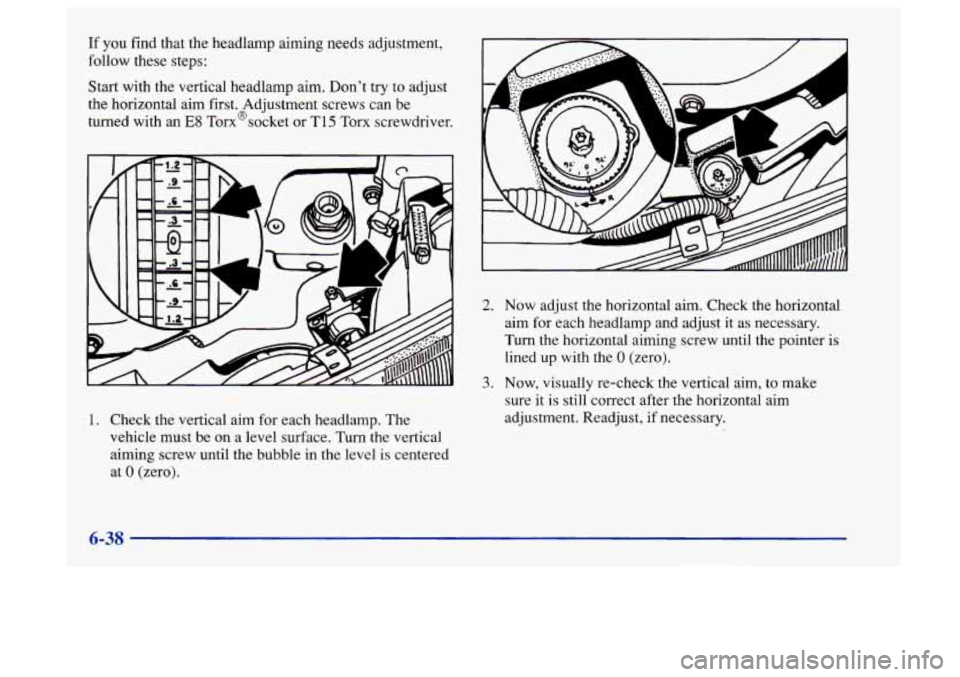
If you find that the headlamp aiming needs adjustment,
follow these steps:
Start with the vertical headlamp aim. Don't try
to adjust
the horizontal aim first. Adjustment screws can be
turned with an
E8 Torx@socket or T15 Torx screwdriver.
1. Check the vertical aim for each headlamp. The
vehicle must be on a level surface.
Turn the vertical
aiming screw until the bubble in
the level is centered
at
0 (zero).
2. Now adjust the horizontal aim. Check the horizontal
aim for each headlamp and adjust it as necessary.
Turn the horizontal aiming screw until the pointer is
lined up with the
0 (zero).
3. Now, visually re-check the vertical aim, to make
sure it is still correct after the horizontal aim
adjustment. Readjust,
if necessary.
6-38